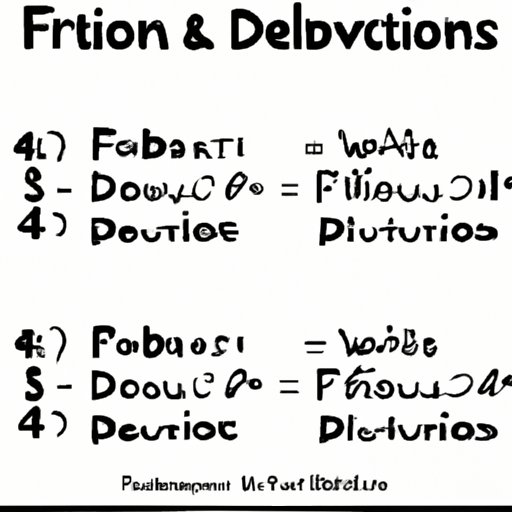
Dividing Fractions: A Beginner’s Guide to Mastering the Concept
Fractions may seem daunting to some, but it’s an essential part of mathematics that we encounter in everyday life. Dividing fractions, in particular, can be a tricky concept to grasp but it’s an extremely useful skill to have. In this article, we’ll explore the different methods of dividing fractions, and provide you with the tools you need to master it.
Explanation with Example
Before diving into the nitty-gritty details, let’s define what dividing fractions is. Dividing one fraction by another is the same as multiplying the first fraction by the reciprocal of the second fraction. In simpler terms, it’s flipping the second fraction upside down, and then multiplying the two fractions across (or straight across). For example:
2/3 ÷ 5/6 = 2/3 x 6/5
Once we have this multiplication problem, we simply multiply the numerators (top numbers):
2 x 6 = 12.
Then, we multiply the denominators (bottom numbers):
3 x 5 = 15.
Therefore, the answer is 12/15. We can simplify this answer by finding the greatest common factor (GCF) of the numerator and denominator, which is 3. We divide both the numerator and denominator by 3:
12/15 ÷ 3/3 = 4/5.
So, 2/3 ÷ 5/6 = 4/5.
Finding the Least Common Denominator
When dividing fractions with different denominators, it’s essential to find the least common denominator (LCD). The LCD is the smallest multiple that both denominators have in common. Here’s how to find it:
Step 1: Look at the denominators and list their multiples.
For example, if we want to divide 1/2 by 1/3, we list the multiples of 2 and 3:
2, 4, 6, 8, 10, 12, …
3, 6, 9, 12, …
Step 2: Identify the smallest multiple that both denominators share. In this example, the smallest multiple is 6.
Step 3: Rewrite each fraction with the common denominator.
1/2 becomes 3/6 (because we multiplied both the numerator and denominator by 3), and 1/3 becomes 2/6 (because we multiplied both the numerator and denominator by 2).
Step 4: Complete the division. Now that both fractions have the same denominator, we can divide them:
3/6 ÷ 2/6 = 3/6 x 6/2 = 18/12.
We can simplify this answer by finding the GCF of the numerator and denominator, which is 6. We divide both the numerator and denominator by 6:
18/12 ÷ 6/6 = 3/2.
Therefore, 1/2 ÷ 1/3 = 3/2.
Reciprocal Method of Dividing Fractions
Another way to divide fractions is through the reciprocal method, which involves flipping the second fraction upside down (finding its reciprocal), and then multiplying the two fractions across (straight across). Here’s an example:
2/3 ÷ 5/6 = 2/3 x 6/5.
Now, we can multiply the numerators (top numbers):
2 x 6 = 12.
Then, we multiply the denominators (bottom numbers):
3 x 5 = 15.
Therefore, the answer is 12/15. We can simplify this answer by finding the GCF of the numerator and denominator, which is 3.
We divide both the numerator and denominator by 3:
12/15 ÷ 3/3 = 4/5.
So, 2/3 ÷ 5/6 = 4/5.
Word Problems
Let’s practice the concepts we just learned with a few word problems:
Example 1: Sarah needs to slice a 3/4 pound of cake into 1/8 pound slices. How many slices can she make?
Solution: To find out the answer, we have to divide the total cake weight by the weight of each slice. The problem looks like this:
3/4 ÷ 1/8 = ?
Using the reciprocal method:
3/4 ÷ 1/8 = 3/4 x 8/1 = 24/4 = 6.
Therefore, Sarah can make six 1/8-pound slices from a 3/4-pound cake.
Example 2: If it takes Julia 2/3 hour to walk 4/5 mile, how long will it take her to walk 1 mile?
Solution: We can use the reciprocal method again:
2/3 ÷ 4/5 = 2/3 x 5/4 = 10/12.
Now, we can simplify this fraction by finding the GCF, which is 2:
10/12 ÷ 2/2 = 5/6.
Finally, we need to find out how long it will take Julia to walk 1 mile:
5/6 ÷ 4/5 = 5/6 x 5/4 = 25/24.
Therefore, it will take Julia 25/24 hours to walk 1 mile.
Illustrations/Graphics
Visual learners may benefit from seeing a graphical representation of how to divide fractions. Here’s an example:

Common Pitfalls
Dividing fractions is a complex process that can lead to common mistakes. One of the most significant pitfalls is forgetting to change the fraction to its reciprocal before multiplication. Be sure to double-check before finalizing your answer.
Practice Problems
Here are some practice problems for you to try:
1. 2/3 ÷ 3/5 = ?
2. 5/6 ÷ 1/2 = ?
3. 9/10 ÷ 3/4 = ?
Scroll down for the answers and explanations.
Conclusion
Dividing fractions may seem daunting at first, but it’s a critical skill to have in many real-life situations. We hope this beginner’s guide has provided you with a better understanding of the concept. Remember to use the reciprocal method, find the least common denominator, and practice, practice, practice.





